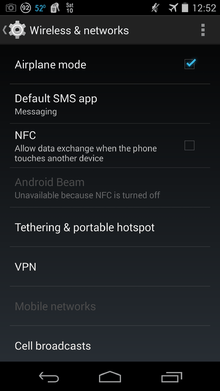Airplane mode

Airplane mode, aeroplane mode, flight mode, offline mode, or standalone mode is a setting available on smartphones and other portable computers that, when activated, suspends radio-frequency signal transmission by the device, thereby disabling Bluetooth, telephony, and Wi-Fi. GPS may or may not be disabled, because it does not involve transmitting radio waves.
The name comes from the prohibition by most of the airlines of using equipment transmitting radio-frequency signal while in flight; using airplane mode prevents devices from transmitting.
When the "aeroplane mode" is activated, it disables all voice, text, telephone, and other signal-transmitting technologies such as Wi-Fi and Bluetooth. Wi-Fi and Bluetooth can be enabled separately even while the device is in airplane mode; this is acceptable on some aircraft.[1][2] Receiving radio-frequency signals, as by radio receivers and satellite navigation services, is not inhibited. However, even receiving telephone calls and messages without responding would require the phone to transmit.
In a revised review in October 2013, the United States Federal Aviation Administration (FAA) made a recommendation on the use of electronic devices in "airplane mode"—cellular telephony is disabled, while Wi-Fi may be used if the carrier offers it. Short-range transmission such as Bluetooth is always permissible. The statement cites the common practice of aircraft operators whose aircraft can tolerate use of these personal electronic devices, but use may still be prohibited on some models of aircraft.[3]
While in airplane mode, most devices allow the user to continue to use their email client or other program to write text or E-mail messages which are saved in memory to send when airplane mode is disabled.
Although it is not possible to make normal calls or send text in airplane mode, devices such as some Nokia smartphones allow the user to make calls to emergency services even in airplane mode, while others do not.
As a side-effect, airplane mode reduces power consumption and increases battery endurance by shutting down the device's transmitters and receivers.
Legal status in various nations
- China: Prior to September 2017, all cell phones, even with Airplane mode, were never allowed to be used during the flight although other devices can be used while in cruising altitude. On September 18, 2017, the Civil Aviation Authority of China relaxed these rules and allowed all Chinese air carriers to allow the use of Portable Electronic Devices (PEDs) for the entire flight as long as they're in Aeroplane Mode.[4]
- Europe: On December 9, 2013, the European Aviation Safety Agency updated its guidelines on portable electronic devices (PEDs), allowing them to be used throughout the whole flight as long as they're set in Airplane mode.[5]
- India: On 23 April 2014, the Directorate General of Civil Aviation (DGCA) amended the rule which bans use of portable electronic devices and allowing their usage in all phases of flight.[6]
References
- ↑ "iOS: Understanding airplane mode". Apple Support. April 14, 2015.
If allowed by the aircraft operator and applicable laws and regulations, you can re-enable Wi-Fi and Bluetooth while in airplane mode
- ↑ "Android: AIRPLANE_MODE_RADIOS".
A comma separated list of radios that need to be disabled when airplane mode is on. This overrides WIFI_ON and BLUETOOTH_ON, if Wi-Fi and bluetooth are included in the comma separated list.
- ↑ "FAA to Allow Airlines to Expand Use of Personal Electronics". Federal Aviation Administration. 2014-10-31.
Cell phones should be in airplane mode or with cellular service disabled—i.e., no signal bars displayed—and cannot be used for voice communications based on FCC regulations that prohibit any airborne calls using cell phones. If your air carrier provides Wi-Fi service during flight, you may use those services. You can also continue to use short-range Bluetooth accessories, like wireless keyboards. [...] The PED Aviation Rulemaking Committee (ARC) concluded most commercial airplanes can tolerate radio interference signals from PEDs. In a recent report, they recommended that the FAA provide airlines with new procedures to assess if their airplanes can tolerate radio interference from PEDs. Once an airline verifies the tolerance of its fleet, it can allow passengers to use handheld, lightweight electronic devices—such as tablets, e-readers, and smartphones—at all altitudes
- ↑ "China's air passengers could soon be allowed to use smartphones". scmp.com.
- ↑ Attwooll, Jolyon (5 February 2016). "Regulator confirms tablets safe to use during take-off" – via www.telegraph.co.uk.
- ↑ "DGCA allows in-flight use of mobile phones, tablets on flight mode". indianexpress.com. 23 April 2014.
External links
- Copa Airlines' cell phone policy
- QANTAS policy on usage of flight mode